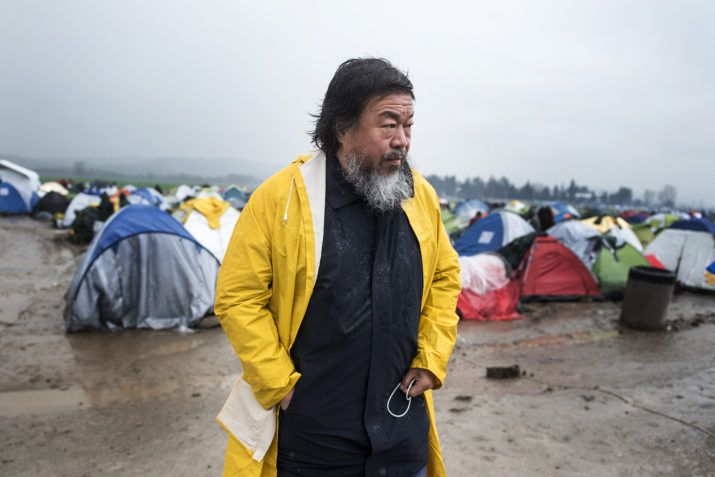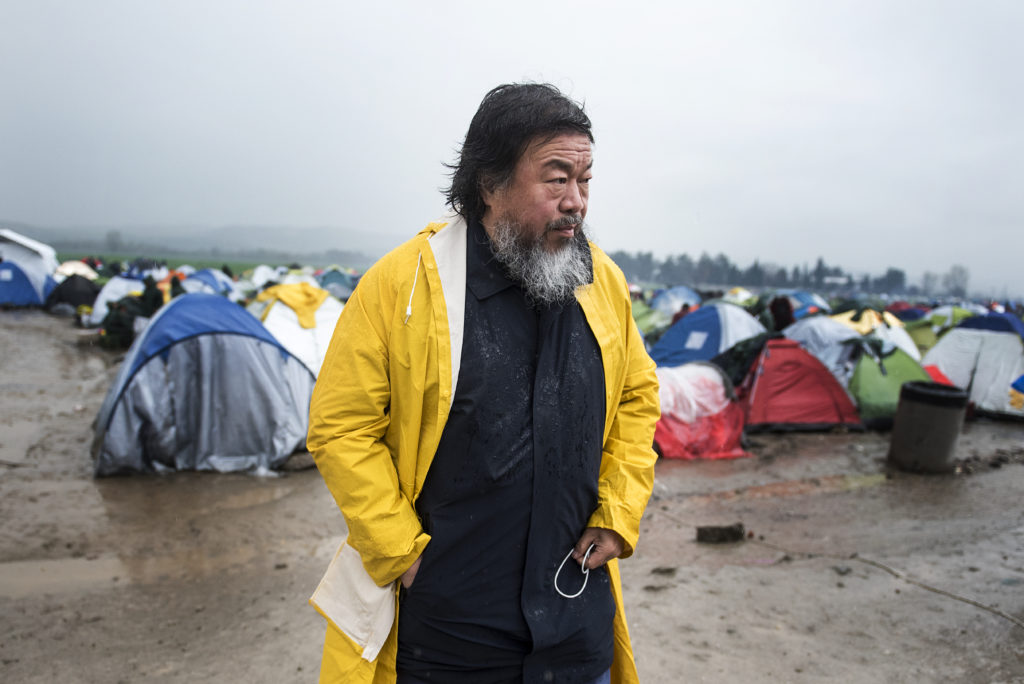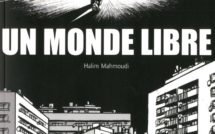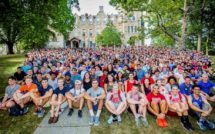

This is part of our special feature, United in Diversity.
The trouble started well before Ai Weiwei arrived in Berlin.
Born in 1957, Ai emerged from the Chinese art scene in the late 1970s and early 1980s, during a period in which officials increasingly, if intermittently, altered cultural policies in the country and allowed for aesthetic engagement outside of China. Formalized and less programmatic art education was allowed again in the country, starting around 1977, when arts academies were reopened in the aftermath of the Chinese Cultural Revolution. Ai studied and produced art for a period of time in the 1980s in San Francisco, Philadelphia, and New York, where he became directly familiar with the works of artists such as the Dadaist Marcel Duchamp, the Neo-Dadaist Jasper Johns, and as shown here, Pop artist Andy Warhol.[1]
After nearly a decade in the United States, Ai returned in 1993 to China and continued an active practice and spoke openly about Chinese censorship. Throughout the mid-2000s, the artist engaged in an active web-based practice critical of Chinese policies via such portals as Sina-Weibo, a microblogging website.
It was as a result of his collaboration for the 2008 summer Olympics with architects Jacques Herzog and Pierre de Meuron on the Beijing National Stadium – the so-called Bird’s Nest[2] – that Ai’s criticisms of the Chinese government found an even broader, more receptive international audience. He developed a robust social media presence, increasingly using now-notorious platforms such as Twitter to call attention to human rights abuses, primarily in China, and to present almost real-time criticisms of governmental policies and police actions. As a result, Ai was arrested numerous times by Chinese authorities, most notably on April 3, 2011, when he was held for some eighty-one days. A period of enforced silence, followed by extensive travel restrictions, prevented the artist from leaving China. Finally, in July 2015, Ai Weiwei’s passport was returned by the Chinese government and he was again allowed to leave the country despite ongoing governmental surveillance. He left almost immediately for Berlin, where he began a delayed three-year artist residency at the Universität der Künste (University of the Arts, or UdK). Although he could possibly remain longer in Germany, the artist announced in early 2018 that he would be leaving the country at the end of his UdK residency.
Even prior to his Berlin residency, Ai Weiwei had developed artworks that challenged governmental and regulatory bodies, often by showcasing bodies that had gone missing. In Remembering, his 2009 piece for the Haus der Kunst, in Munich, Germany, for example, the artist placed backpacks on the museum’s outside facade, creating a memorial wall to represent victims of an earthquake the year prior in Sichuan, China[3]. Each backpack represented one child killed in the catastrophe. Spelled out in Mandarin on the backpacks, viewers could read the phrase, She lived happily for seven years in this world. Key for understanding this work, and the conflation of bodies – his own, and those of others – in Ai Weiwei’s work during his Berlin residency, is the conspicuous absence this work represents: There are no children here, no victims. Only backpacks. Only signifiers of lost lives, representations of the victims that might otherwise be present.
Increasingly during his Berlin residency, Ai Weiwei would develop his strategy of utilizing victims’ absent bodies in his efforts to create a “present absence:” The allusion to victims, the deployment of signifiers of victims’ bodies, even as these victims’ identities themselves were not widely circulated. Turning his critical lens away from Chinese-specific events to ones decidedly more global in nature, his various works examining the plight of refugees across the world took many forms. Often these works were not focused on a specific country, but rather on regional or even global policies around refugees, migration, and access.
In 2016, Ai placed some 14,000 life jackets on the columns of the Konzerthaus on the Gendarmenmarkt in Berlin as part of an installation, which was accompanied by a large, vertical sign with the Twitter-ready coupling #safepassage.[4] Much like the backpacks used in Remembered, these life jackets serving as signifiers were used to represent bodies that themselves were not present. In contrast to the artist’s display at the Kunsthaus in Munich several years earlier however, these 14,000 life jackets presumably represented living people: individuals fleeing Syria, Iraq, and other countries that had arrived on the Greek island of Lesbos. The display, while seeking to draw attention to the global refugee crisis, made no mention of the fact the life jackets themselves most likely were non-functional, the product of an industry developed by smugglers in which these objects would never actual function for their supposed purpose: life jackets that could actually prevent their wearers from drowning. This fact, however, was shared in a film about the global refugee crisis that Ai would later release.
Ai Weiwei continued into 2017 his focus on the global refugee crises, employing again signifiers of refugees, signifiers of their absent bodies, without actually circulating these refugees’ identities. Appearing at both the National Gallery in Prague, Czech Republic, and later on Cockatoo Island as part of the Sydney Biennale in Australia, Law of the Journey used materials similar to those found in actual lifeboats to create a replica of these vessels, albeit a replica filled with faceless refugees in apparent transit to Europe and to safety.[5] Some of the boats inhabitants appear to have fallen overboard, lying outside the raft and on the gallery floor, presumably dead. The didactic material for the Czech exhibit emphasized the artist’s vision for this work:
The National Gallery in Prague hosts the Law of the Journey by Ai Weiwei, focusing on refugees. Himself a refugee, Ai has almost entirely focused his work on advocating the refugees’ human rights and documenting their tragic condition throughout the past two years.
In the didactic material, the artist’s Law of the Journey is situated in terms of personal experiences, experiences that are seen as emblematic of the subject of his art. The conflation of artist and artwork, messenger and message, further blurs the boundaries between Ai’s body and the real bodies of the faceless, nameless victims that inspired the work. These victims’ bodies are present but only in their absence; it is Ai Weiwei whose identity is central.
Similar to #safepassage and Law of the Journey, Ai Weiwei’s collection of abandoned shoes, clothing, and other artifacts that comprise his Laundromat installation reference bodies that are not present.[6] First shown at the Deitch Projects in New York in 2016, and reinstalled in 2018 for exhibition at the Fire Station’s Garage Gallery in Doha at the invitation of the Qatar Museum, Laundromat is comprised of 2,046 pieces of refugee clothing washed, ironed, and sorted by type. According to the artist, refugees left the items in Idomeni, Greece, at a makeshift refugee camp near the Macedonian border when the camp was shut down in May 2016. Ai and his team brought the items to his Berlin studio in order to prepare these items for the installation. In addition to showcasing these abandoned signifiers of refugee bodies, the exhibition space’s floor was covered with articles about the refugee crisis. A wallpaper made from over 17,000 images Ai had taken on his phone at the camp was spread across the exhibition’s walls.
The camp at Idomeni features extensively in the artist’s 2017 cinematic effort, Human Flow. Comprised of extensive, on-site footage of Ai and his crew of assistants, photographers, and camera operators, the film depicts numerous scenes of refugees in crisis, in transition camps, on extensive journeys to seek safety, shelter, and refuge. The film is shot extensively using hand-held cameras, cell phones, and drones. The technology used to shoot the film at the various sites is almost as omnipresent as the artist himself. Few cinematographic conventions are employed to disrupt the viewer’s experience of the refugee crisis as itself a kind of serene, poetic event, strategies most evident in the numerous wide-angle shots and extensive use of scenes filmed using drones. There are no jump-cuts, for example, and few shots that incorporate the unsteady imagery of the cinematographer’s own hand. The artist appears repeatedly in the film, acting in turns as catalyst for confrontation with local authorities, impassioned interlocutor, and – occasionally – as substitute for the refugees themselves, as when he jokes about trading passports with one of the residents or gets a shave and a haircut from a barber at the camp.[7]
Through his Berlin residency and his engagement with the global refugee crisis, Ai Weiwei has become increasingly vocal, if not also increasingly aware, of the complicity of the West’s socio-economic policies with Chinese humanitarian abuses. Late in January 2019 and in anticipation of a large-scale exhibition of his work titled Unbroken,[8], Ai released a statement through the Gardiner Museum in Toronto, Canada. In the statement, the artist suggested that it was the West that is “the hidden force behind China’s rise” and accused the West of “profiting from the status quo.” Ai’s statement is worth quoting at length:
Today, China is the second biggest economic power in the world, only behind the United States of America. Though China has quickly developed, the West has also greatly benefited from this partnership through the exploitation of many Chinese basic rights in terms of labor, environmental damage, corruption, among other such issues.
The West has pretended to not notice [sic] or, more insidiously, has been a willing partner.
They are the hidden force behind China’s rise. And while China has become an ever more powerful machine, it still has not changed its authoritarian tendencies….
China has been the perfect dream of the West. Under the banner of globalization, China has been able to do everything that the West could not and [has] been instrumental in helping the democratic states become what they are today. The West’s apparent conflict with the situation in China is because of its refusal to acknowledge its complicity in creating this monstrous regime.
The recognition of the West’s mutual benefit from Chinese policies, while perhaps not altogether new to the artist, finds one of its most explicit denouncements as he transitions from a long-term stay in Germany. As much as his departure is a condemnation of the West’s relationship to China, Ai’s decision to leave Berlin is also inseparable from his rejection of Western political impotence in the face of increasing neo-national and xenophobic activities. In a sense, Ai’s decision to leave Germany – apparently to relocate his home to the United States, specifically to Connecticut – does not mean he is abandoning his Berlin base however. He plans to retain his studio in Prenzlauer Berg, much as he continues to have active studios in other cities, including Beijing. But Ai’s departure from Germany points to the limits of his work’s ability to engender change – and is, as the artist himself notes, a result of his own encounters in his host country.
Ai Weiwei clarified in a late December 2018 interview published in The Guardian his decision to leave Berlin (Connelly, 2018). The focus of the interview was a commission Ai received from arts organizations and human rights charities in the United Kingdom. The commission was for the 70th anniversary of the Universal Declaration of Human Rights, for which the artist was asked to design a flag.[9] When pressed on his reasons for leaving Berlin during the interview, however, Ai conveyed a personal story and related it to the plight of the refugees for whom he sees himself as spokesperson. A German taxi driver refused to transport the artist and his son when Ai, who apparently was listening to a message from his mother, would not shut off his mobile phone. The driver, according to Ai, “told me to get out of the car, and when I said I wouldn’t he slammed on the brakes and we all fell forward. My son hit his head. [The driver] used his vehicle on a public street to express his anger” (Connolly, 2018). Connecting this personal encounter to the state of public discourse and political policy in Germany as a whole, Ai continued:
So you see I am fighting battles wherever I go – including with German people who say I should be grateful to them because I am a refugee, and they paid for my life. This is the mood in Germany right now, the posters I see in the streets saying: “We can make our own babies, we don’t need foreigners.” It’s the mood in much of Europe, including the UK. It’s very scary because this kind of moment is a reflection of the 1930s. (Connolly, 2018)
The degree to which Ai’s personal encounter in the taxi compares to the plight of refugees in contemporary Europe, or in 1930s Europe for that matter, is important to note; but what is most problematic is the way in which Ai Weiwei again aligns himself in the interview with the often faceless, nameless refugees who serve as the catalyst for his artworks. In seeking to draw attention to these faceless, nameless refugees, Ai Weiwei often draws more attention to himself and his celebrity, thereby increasing his profile globally.
Clearly as much as the artist tried in other works to separate his own body from the art he created, his body proved inseparable from the impact he hoped to achieve. There remains clear distinctions between the earlier work Ai created, targeting Chinese censorship, and his current focus on the global refugee crisis, a crisis he is clear to note with which the West is complicit. His celebrity, his identity as a Chinese dissident artist, an enfant terrible embraced by the West, increasingly make nearly impossible a focus on the artwork’s message independent of his celebrity, and his own body often replaces the body of these refugees in press releases, public engagements, and even in some of the works themselves.
Ai Weiwei’s stature as a globally-recognized figure gives him an impressive public stage on which to showcase his artwork and his artistic message. And the artist has chosen to focus on a cause with global appeal during his three-year residency in Berlin – and now beyond it as well. As Ai notes in an interview in November 2018 in artnet, the avowed reason for his artmaking is, still, the potential it has to impact others, to engender a kind of very powerful affect: “… I think art touches very essential emotions, a way of judging ourselves. Those are very important human activities” (Loos, 2018).
That artist Ai Weiwei’s body is a vehicle for his political messages will come as no surprise for those familiar with his work. Marie Leduc, in Dissidence: The Rise of Contemporary Chinese Art in the West, suggests that artists such as Ai Weiwei engage in “activist or social interventionist art” that “mobilizes the value of dissidence” and plays on the trope of “Chinese-artist-as-dissident” (Leduc 2018, 12, 14, 34). But it is difficult to continue to label Ai Weiwei merely a “Chinese-artist-as-dissident.” Beginning in 2015 with his UdK residency in Berlin, he became increasingly an artist engaged in the refugee crisis as a global art project. Intentionally and unintentionally, Ai’s body has become inseparable from the affect of his art. This collusion is most evident in one particularly controversial photograph.[10]
In late 2015, the artist collaborated with photographer Rohit Chawla from India Today to recreate a now-iconic image: the photograph of Syrian toddler, Aylan Kurdi, who drowned off the coast of Turkey. The image of this young victim, taken by photographer Nilüfer Demir, circulated widely in newspapers, television programs, as well as on social media and the internet. Articles in The Washington Post circulated Ai’s restaged beach photograph and declared that the dead boy “just got a huge artistic tribute” (Lakshmi, 2016). The artist himself was at pains to understand concerns with the restaged photo, with replacing the body of a young, dead refugee with his own body: “I think the so-called criticism I have received has no merit … Where does this anger come from? They can’t accept this reality? When people try to guard certain topics, it only shows the weakness of their minds and their own moral standings” (Urist, 2017).
It is important to note that Ai and Chawla were not the only individuals to engage the original image to draw attention to the plight of refugees like Kurdi. The public shock when confronted with the image of Kurdi’s lifeless body resulted in a number of reproductions and reinterpretations of the original image, and many of these reproductions sought to engender sympathy with respect to the plight of refugees coming to Europe, in particular. But it is Chawla and Ai’s reproduction of the image of Kurdi, and the specific decision to put the artist’s own body in place of the drowned boy’s body in the original photograph, that crystalizes an important point concerning Ai’s affect, an affect that results from conflation of the artist’s position with that of his art, with his body for victims’ bodies vis-a-vis his installations, statements, and films.
Writing in 1908, Henri Bergson suggested in his Matter and Memory a particular role for affect, one that hints at the revolutionary potential of art and the aesthetic experience:
Affection is, then, that part or aspect of the inside of our own body, which we mix with the image of external bodies; it is what we must first of all subtract from perception to get the image in its purity. (Bergson 2005, 58)
It is in this vein that Bergson also noted a particularly vexing indistinguishability between viewer and image, between perceiving subject and perceived object. Bergson claims that when the body itself coincides with the object to be viewed, the “distance is reduced to zero” (Bergson 2005, 57). In other words, and in Bergson’s terms, when body and object coincide, the distinction between sensation and perception, between real action and possible action, is rendered indistinguishable.
It is this problematic reduction “to zero” that makes Ai Weiwei’s status as an artist exemplary of the limits of the body, of art’s ability to influence politics, of the limits of the aesthetic encounter and – above all – the ability of the artist’s own affect. To these ends, Ai Weiwei’s body must be understood in two, often inseparable, senses. His body is both the literal body of the artist – Ai Weiwei’s physical presence – and also the artist’s body of artworks, a body that is experienced by viewers and participants in his artistic interventions. Ai Weiwei’s physical body, as distinct as it at times may seem, is often inseparable from his body of artworks. The artist often uses his body to focus the viewer’s attention on the absences of others’ bodies. It is Ai Weiwei’s body in this double, irreducible sense – as his body, and the body of his works – that is the increasingly problematic, visible cypher through which to read his affect.
Thomas O. Haakenson is Associate Professor in Critical Studies and Visual Studies at California College of the Arts in San Francisco and Oakland, USA. He is co-editor of the book series Visual Cultures and German Contexts and has co-edited several anthologies. Haakenson has received awards and fellowships from the United States Fulbright Program, the Social Science Research Council, the Max Planck Institute for the History of Science, the Deutscher Akademischer Austauschdienst, and the Berlin Program for Advanced German and European Studies, among others.
References
Ai Weiwei: Unbroken. Gardiner Museum, Toronto, Canada. <https://www.gardinermuseum.on.ca/event/ai-weiwei-unbroken/>. Accessed 21 February 2019.
Bergson, Henri. Matter and Memory. New York: Zone Books, 1908, 2005.
Connolly, Kate. “Ai Weiwei: ‘The mood is like Germany in the 1930s’” (interview). The
Guardian. 9 December 2018. <https://www.theguardian.com/artanddesign/2018/dec/10/ai-weiwei-interview-un-declaration-human-rights-70th-anniversary>. Accessed 21 February 2019.
Jayaraman, Gayatri, “Artist awash in the land of refugees,” Special Report, India Today
Magazine. 3 February 2016. < https://www.indiatoday.in/magazine/special-report/story/20160215-ai-weiwei-tribute-to-syrian-refugee-aylan-kurdi-828413-2016-02-03>. Accessed 21 February 2019.
Köppel-Yang, Martina. Semiotic Warfare: The Chinese Avant-Garde, 1979-1989. Hong Kong:
Timezone 8, 2003.
Lakshmi, Rama, “Chinese artist Ai Weiwei poses as a drowned Syrian refugee toddler,”
The Washington Post. 29 January 2016. <https://www.washingtonpost.com/news/worldviews/wp/2016/01/30/chinese-artist-ai-weiwei-poses-as-a-drowned-syrian-refugee-toddler/?utm_term=.4f099476c12e>. Accessed 21 February 2019.
Lakshmi, Rama, “Syrian refugee crisis: Artist Ai Weiwei poses as Aylan Kurdi for India Today
magazine,” India Today Magazine. 5 February 2016. <https://www.indiatoday.in/india/photo/syrian-refugee-crisis-artist-ai-weiwei-poses-as-aylan-kurdi-for-india-today-magazine-377881-2016-02-05/3>. Accessed 21 February 2019.
Leduc, Marie. Dissidence: The Rise of Chinese Contemporary Art in the West. Cambridge: The MIT Press, 2018.
Loos, Ted. “‘Who Needs Another Show?’ Ai Weiwei Says He’s Over the Whole Museum Thing
and Is Moving to Connecticut.” artnet. 15 November 2018. <https://news.artnet.com/art-world/ai-weiwei-moving-to-connecticut-over-museums-1396012>. Accessed 21 February 2019.
Munroe, Alexandra with Philip Tinari and Hous Hanru. Art and China After 1989: Theater of the World. Guggenheim: New York, 2017.
Urist, Jacoba. “How Should Art Address Human Rights?” The Atlantic 4 April
2017. <https://www.theatlantic.com/entertainment/archive/2017/04/how-should-art-address-human-rights/521520/>. Accessed 21 February 2019.
[1] https://www.liveauctioneers.com/news/top-news/art-design/warholai-weiwei-exhibit-to-debut-in-australia-in-dec/
[2] https://www.context.ca/blog/2018/03/01/different-by-design-volume-5-olympic-architecture/
[3] https://publicdelivery.org/ai-weiwei-remembering-haus-der-kunst-muenchen-2009/
[4] https://hiveminer.com/Tags/aiweiwei,berlin
[5] https://www.ngprague.cz/en/exposition-detail/aj-wej-wej/
[6] https://www.gulf-times.com/story/585204/QM-welcomes-Ai-Weiwei-s-Laundromat
[7] https://www.youtube.com/watch?v=mha7FvpCDeA
[8] https://www.gardinermuseum.on.ca/event/ai-weiwei-unbroken/
[9] https://www.theguardian.com/artanddesign/2018/dec/10/ai-weiwei-interview-un-declaration-human-rights-70th-anniversary
[10] https://www.indiatoday.in/india/story/artist-ai-weiwei-poses-as-aylan-kurdi-for-india-today-magazine-306593-2016-02-01
Published on April 4, 2019.
Photo: Idomeni, Greece – March 9, 2016. Chinese artist Ai Weiwei during his visit at the makeshift refugee camp of Idomeni in northern Greece, at the Greek – Macedonian border | Shutterstock




